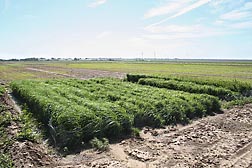Read the magazine story to find out more. |
|
Saving Water in Southern High Plains Dairy Production
By Dennis O’Brien
June 6, 2016
U.S. Department of Agriculture (USDA) scientists are trying to save water in one of the fastest growing dairy regions in the United States by encouraging use of a drought-tolerant crop the same way it’s sometimes used in India—as cattle feed.
Dairy production is growing fast in the Southern High Plains region of West Texas and New Mexico, and most of the dairy producers there use corn silage or alfalfa as a key feed component. Corn and alfalfa require more water than other crops, thus stretching the Ogallala Aquifer, the source of water for that region, beyond capacity.
Prasanna Gowda, an Agricultural Research Service (ARS) engineer, knew that dairy cattle in his native India are raised on finger millet (Eleusine coracana) and that milk from finger millet-fed cows there sells for a higher price.
As part of their research, Gowda and his colleagues grew five finger millet varieties in Bushland for 120 days, selecting plants of each variety based on crude protein, fiber content, and other nutritional qualities. They compared the finger millet’s nutritional qualities to those of corn and sorghum from neighboring plots.
Gowda found that finger millet had higher levels of potassium than corn, twice as much calcium, four to five times as much phosphorus, and comparable levels of protein, fiber and total digestible nutrients. (Calcium and phosphorus deficiencies reduce dairy cattle’s appetites and growth and lower milk production.) Finger millet also used less water than corn and sorghum. The one drawback was that finger millet produced lower yields than corn.
The results showed that finger millet could be a viable feed source for dairy cattle as a supplement to corn and that it could help save water in areas where water is limited, Gowda says.
Gowda was based in Bushland, Texas at the time of the study, but has since moved to the ARS Grazinglands Research Laboratory in El Reno, Oklahoma.
ARS is USDA’s principal intramural scientific research agency. Read more about this research in the June 2016 issue of AgResearch magazine.

